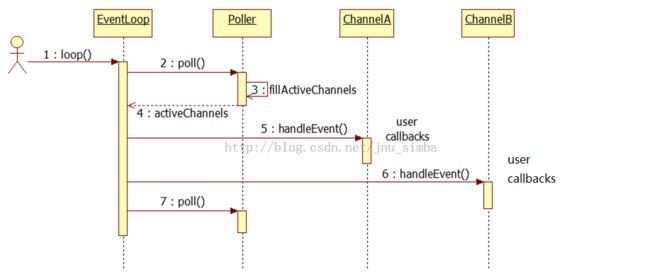muduo网络库学习之EventLoop(二):进程(线程)wait/notify 和 EventLoop::runInLoop
1、进程(线程)wait/notify
pipe
socketpair
eventfd
socketpair
eventfd
eventfd 是一个比 pipe 更高效的线程间事件通知机制,一方面它比 pipe 少用一个 file descripor,节省了资源;另一方面,eventfd 的缓冲区管理也简单得多,全部“buffer” 只有定长8 bytes,不像 pipe 那样可能有不定长的真正 buffer。
C++ Code
|
1
2 3 4 5 6 7 8 9 |
// 该函数可以跨线程调用
void EventLoop::quit()
{ quit_ = true; if (!isInLoopThread()) { wakeup(); } } |
如果不是当前IO线程调用quit,则需要唤醒(wakeup())当前IO线程,因为它可能还阻塞在poll的位置(EventLoop::loop()),这样再次循环判断 while (!quit_) 才能退出循环。
一般情况下如果没有调用quit(),poll没有事件发生,也会超时返回(默认10s),但会继续循环。
时序分析:
构造一个EventLoop对象,构造函数初始化列表,构造poller_, timeQueue_, wakeupFd_, wakeupChannel_ 等成员,在函数体中:
C++ Code
|
1
2 3 4 |
wakeupChannel_->setReadCallback(
boost::bind(&EventLoop::handleRead, this)); // we are always reading the wakeupfd wakeupChannel_->enableReading(); |
调用Channel::setReadCallback 注册wakeupChannel_ 的回调函数为EventLoop::handleRead, 调用Channel::enableReading(); 接着调用Channel::update(); 进而调用EventLoop::UpdataChannel(); 最后调用
Poller::updataChannel();(虚函数,具体由子类实现),此函数内添加一个新channel或者
更新此channel关注的事件,现在是将wakeupChannel_ 添加进PollPoller::channels_(假设Poller类用PollerPoller类实现) 中,并使用wakeupChannel_.fd_ 和 wakeupChannel_.events_ 构造一个struct pollfd, 并压入pollfds_; 以后将关注wakeupChannel_ (wakeupFd_) 的可读事件。

事件循环开始EventLoop::loop(),内部调用poll()(这里假设调用的是PollPoller::poll(), 内部调用::poll())。::poll() 阻塞返回即事件发生,如timerfd_超时可读; socket 有数据可读/可写;
非IO线程调用EventLoop:quit(), 进而调用wakeup(),
非IO线程
往wakeupFd_ 中write 入8个字节数据,此时wakeupFd_可读。现在假设是wakeupFd_ 可读,PollPoller::poll()调用PollPoller::fillActiveChannels()(虚函数), 函数内使用(struct pollfd).revents 设置此channel的revents_,然后将此channel 压入EventLoop::activeChannels_ 中后返回。PollPoller::poll() 返回,EventLoop::loop()中遍历activeChannels_,对每个活动channel调用Channel::handleEvent(),进而调用每个channel注册的读/写回调函数。
由上面分析可知,wakeupChannel_ 的回调函数为EventLoop::handleRead,函数内调用read 掉 wakeupFd_ 的数据,避免一直触发。
2、EventLoop::loop、runInLoop、queueInLoop、doPendingFunctors
EventLoop 有个pendingFunctors_ 成员:
C++ Code
|
1
2 |
typedef boost::function<
void()> Functor;
std::vector<Functor> pendingFunctors_; |
四个函数的流程图和实现如下:

C++ Code
|
1
2 3 4 5 6 7 8 9 10 11 12 13 14 15 16 17 18 19 20 21 22 23 24 25 26 27 28 29 30 31 32 33 34 35 36 37 38 39 40 41 42 43 44 45 46 47 48 49 50 51 52 53 54 55 56 57 58 59 60 61 62 63 64 65 66 67 68 69 70 71 72 |
// 事件循环,该函数不能跨线程调用
// 只能在创建该对象的线程中调用 void EventLoop::loop() { // 断言当前处于创建该对象的线程中 assertInLoopThread(); while (!quit_) { pollReturnTime_ = poller_->poll(kPollTimeMs, &activeChannels_); eventHandling_ = true; for (ChannelList::iterator it = activeChannels_.begin(); it != activeChannels_.end(); ++it) { currentActiveChannel_ = *it; currentActiveChannel_->handleEvent(pollReturnTime_); } currentActiveChannel_ = NULL; eventHandling_ = false; doPendingFunctors(); } } // 为了使IO线程在空闲时也能处理一些计算任务 // 在I/O线程中执行某个回调函数,该函数可以跨线程调用 void EventLoop::runInLoop( const Functor& cb) { if (isInLoopThread()) { // 如果是当前IO线程调用runInLoop,则同步调用cb cb(); } else { // 如果是其它线程调用runInLoop,则异步地将cb添加到队列,让IO线程处理 queueInLoop(cb); } } void EventLoop::queueInLoop( const Functor& cb) { { MutexLockGuard lock(mutex_); pendingFunctors_.push_back(cb); } // 调用queueInLoop的线程不是当前IO线程则需要唤醒当前IO线程,才能及时执行doPendingFunctors(); // 或者调用queueInLoop的线程是当前IO线程(比如在doPendingFunctors()中执行 functors[i]() 时又调用了queueInLoop())
// 并且此时正在调用pending functor,需要唤醒当前IO线程
// 因为在此时doPendingFunctors() 过程中又添加了任务,故循环回去poll的时候需要被唤醒返回,进而继续执行doPendingFunctors()
// 只有当前IO线程的事件回调中调用queueInLoop才不需要唤醒
// 即在handleEvent()中调用queueInLoop 不需要唤醒,因为接下来马上就会执行doPendingFunctors(); if (!isInLoopThread() || callingPendingFunctors_) { wakeup(); } } // 该函数只会被当前IO线程调用 void EventLoop::doPendingFunctors() { std::vector<Functor> functors; callingPendingFunctors_ = true; { MutexLockGuard lock(mutex_); functors.swap(pendingFunctors_); } for (size_t i = 0; i < functors.size(); ++i) { functors[i](); } callingPendingFunctors_ = false; } |
|
这样,TimeQueue的两个公有成员函数都可以跨线程调用,因为即使是被非IO线程调用,也会放进Queue,然后让当前IO线程来执行:
C++ Code
|
1
2 3 4 5 6 7 8 9 10 11 12 13 14 15 16 17 18 19 |
// 该函数可以跨线程调用 TimerId TimerQueue::addTimer( const TimerCallback &cb, Timestamp when, double interval) { Timer *timer = new Timer(cb, when, interval); loop_->runInLoop( // addTimeInLoop 只能在当前IO线程调用 boost::bind(&TimerQueue::addTimerInLoop, this, timer)); return TimerId(timer, timer->sequence()); } // 该函数可以跨线程调用 void TimerQueue::cancel(TimerId timerId) { loop_->runInLoop( // cancelInLoop 只能在当前IO线程调用 boost::bind(&TimerQueue::cancelInLoop, this, timerId)); } |
进而EventLoop类中的定时器操作函数 runAt, runAfter, runEvery, cancel 都可以跨线程调用,因为实现中调用了TimerQueue::addTimer 和 TimeQueue::cancel .
关于doPendingFunctors 的补充说明:
1、不是简单地在临界区内依次调用Functor,而是把回调列表swap到functors中,这样一方面减小了临界区的长度(意味着不会阻塞其它线程的queueInLoop()),另一方面,也避免了死锁(因为Functor可能再次调用queueInLoop())
2、由于doPendingFunctors()调用的Functor可能再次调用queueInLoop(cb),这时,queueInLoop()就必须wakeup(),否则新增的cb可能就不能及时调用了
3、muduo没有反复执行doPendingFunctors()直到pendingFunctors_为空而是每次poll 返回就执行一次,这是有意的,否则IO线程可能陷入死循环,无法处理IO事件。
测试代码:
C++ Code
|
1
2 3 4 5 6 7 8 9 10 11 12 13 14 15 16 17 18 19 20 21 22 23 24 25 26 27 28 29 30 31 32 33 34 35 36 37 38 39 40 41 42 43 44 45 46 47 48 49 50 |
#include <muduo/net/EventLoop.h>
//#include <muduo/net/EventLoopThread.h> //#include <muduo/base/Thread.h> #include <stdio.h> using namespace muduo; using namespace muduo::net; EventLoop *g_loop; int g_flag = 0; void run4() { printf( "run4(): pid = %d, flag = %d\n", getpid(), g_flag); g_loop->quit(); } void run3() { printf( "run3(): pid = %d, flag = %d\n", getpid(), g_flag); g_loop->runAfter( 3, run4); g_flag = 3; } void run2() { printf( "run2(): pid = %d, flag = %d\n", getpid(), g_flag); g_loop->queueInLoop(run3); } void run1() { g_flag = 1; printf( "run1(): pid = %d, flag = %d\n", getpid(), g_flag); g_loop->runInLoop(run2); g_flag = 2; } int main() { printf( "main(): pid = %d, flag = %d\n", getpid(), g_flag); EventLoop loop; g_loop = &loop; loop.runAfter( 2, run1); loop.loop(); printf( "main(): pid = %d, flag = %d\n", getpid(), g_flag); } |
执行结果如下:
simba@ubuntu:~/Documents/build/debug/bin$ ./reactor_test05
20131108 02:17:05.204800Z 2319 TRACE IgnoreSigPipe Ignore SIGPIPE - EventLoop.cc:51
main(): pid = 2319, flag = 0
20131108 02:17:05.207647Z 2319 TRACE updateChannel fd = 4 events = 3 - EPollPoller.cc:104
20131108 02:17:05.208332Z 2319 TRACE EventLoop EventLoop created 0xBF9382D4 in thread 2319 - EventLoop.cc:76
20131108 02:17:05.208746Z 2319 TRACE updateChannel fd = 5 events = 3 - EPollPoller.cc:104
20131108 02:17:05.209198Z 2319 TRACE loop EventLoop 0xBF9382D4 start looping - EventLoop.cc:108
20131108 02:17:07.209614Z 2319 TRACE poll 1 events happended - EPollPoller.cc:65
20131108 02:17:07.218039Z 2319 TRACE printActiveChannels {4: IN } - EventLoop.cc:271
20131108 02:17:07.218162Z 2319 TRACE readTimerfd TimerQueue::handleRead() 1 at 1383877027.218074 - TimerQueue.cc:62
run1(): pid = 2319, flag = 1
run2(): pid = 2319, flag = 1
run3(): pid = 2319, flag = 2
20131108 02:17:10.218763Z 2319 TRACE poll 1 events happended - EPollPoller.cc:65
20131108 02:17:10.218841Z 2319 TRACE printActiveChannels {4: IN } - EventLoop.cc:271
20131108 02:17:10.218860Z 2319 TRACE readTimerfd TimerQueue::handleRead() 1 at 1383877030.218854 - TimerQueue.cc:62
run4(): pid = 2319, flag = 3
20131108 02:17:10.218885Z 2319 TRACE loop EventLoop 0xBF9382D4 stop looping - EventLoop.cc:133
main(): pid = 2319, flag = 3
simba@ubuntu:~/Documents/build/debug/bin$
20131108 02:17:05.204800Z 2319 TRACE IgnoreSigPipe Ignore SIGPIPE - EventLoop.cc:51
main(): pid = 2319, flag = 0
20131108 02:17:05.207647Z 2319 TRACE updateChannel fd = 4 events = 3 - EPollPoller.cc:104
20131108 02:17:05.208332Z 2319 TRACE EventLoop EventLoop created 0xBF9382D4 in thread 2319 - EventLoop.cc:76
20131108 02:17:05.208746Z 2319 TRACE updateChannel fd = 5 events = 3 - EPollPoller.cc:104
20131108 02:17:05.209198Z 2319 TRACE loop EventLoop 0xBF9382D4 start looping - EventLoop.cc:108
20131108 02:17:07.209614Z 2319 TRACE poll 1 events happended - EPollPoller.cc:65
20131108 02:17:07.218039Z 2319 TRACE printActiveChannels {4: IN } - EventLoop.cc:271
20131108 02:17:07.218162Z 2319 TRACE readTimerfd TimerQueue::handleRead() 1 at 1383877027.218074 - TimerQueue.cc:62
run1(): pid = 2319, flag = 1
run2(): pid = 2319, flag = 1
run3(): pid = 2319, flag = 2
20131108 02:17:10.218763Z 2319 TRACE poll 1 events happended - EPollPoller.cc:65
20131108 02:17:10.218841Z 2319 TRACE printActiveChannels {4: IN } - EventLoop.cc:271
20131108 02:17:10.218860Z 2319 TRACE readTimerfd TimerQueue::handleRead() 1 at 1383877030.218854 - TimerQueue.cc:62
run4(): pid = 2319, flag = 3
20131108 02:17:10.218885Z 2319 TRACE loop EventLoop 0xBF9382D4 stop looping - EventLoop.cc:133
main(): pid = 2319, flag = 3
simba@ubuntu:~/Documents/build/debug/bin$
g_loop->runInLoop(run2); 由于是在当前IO线程,故马上执行run2(),此时flag 还是为1;在run2()内g_loop->queueInLoop(run3);
即把run3()添加到队列,run2()返回,继续g_flag=2,此时loop内已经处理完事件,执行doPendingFunctors(),就执行了run3(),
run3()内设置另一个3s定时器,run3()执行完回到loop继续poll, 3s后超时执行run4(),此时flag=3。
参考:
《UNP》
muduo manual.pdf
《linux 多线程服务器编程:使用muduo c++网络库》

